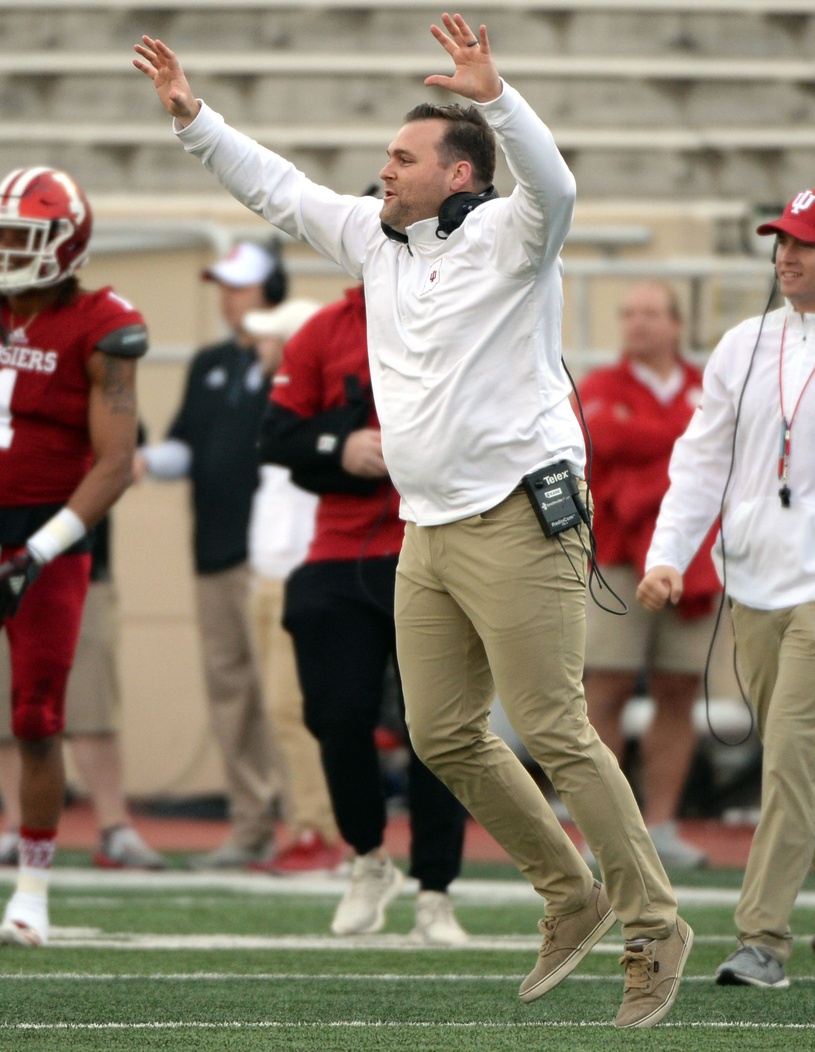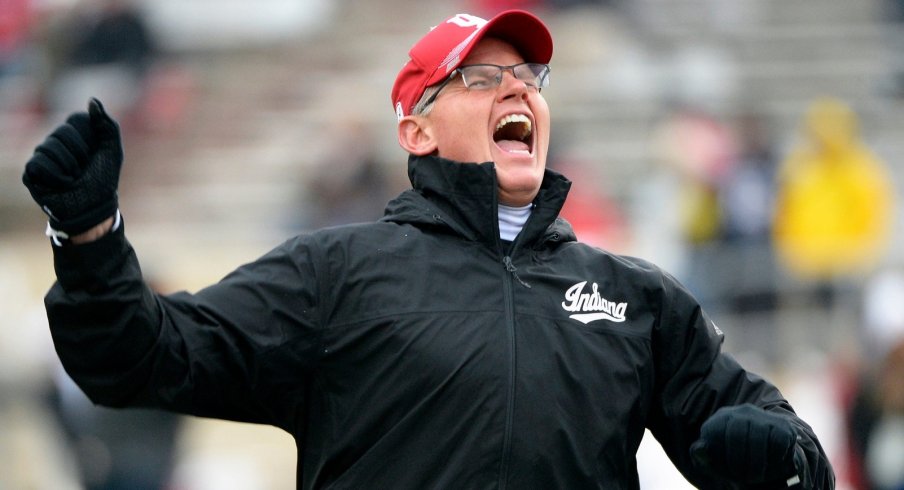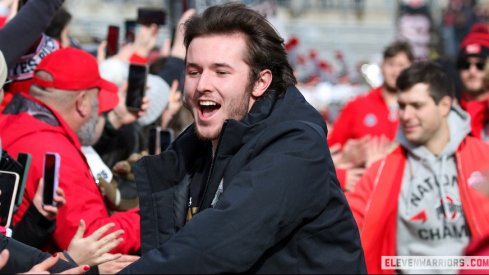"I've never been part of a game where they blitzed that much."
Note: This is the second piece in a series detailing modern defenses and how they remain competitive in this era of unparalleled offensive success. Read part 1 HERE.
Things couldn't have been worse for the Indiana Hoosier defense before Tom Allen arrived in 2016. The unit finished dead-last in the Big Ten in points allowed in 2015, surrendering 37.6 points per game and canceling out the conference's most explosive offense.
On three occasions that fall, the Hoosiers scored at least 40 points and still lost, leading then-head coach Kevin Wilson to overhaul his defense. Though he was an Indiana native and spent much of his early career coaching at the high school level in the state, Allen cut his teeth at the college level in the southeast, emerging as a respected defensive mind after stops at Arkansas State, Ole Miss, and South Florida.
During his lone season at USF, Allen's defense led the American Athletic Conference in points allowed while finishing in the top 20 nationally in tackles-for-loss and interceptions. Such production, combined with local ties, made him an ideal defensive coordinator for Wilson at the time.
While 2016 saw big improvements from the Hoosier defense with Allen at the helm, it was still a surprise to many when he was promoted to head coach following Wilson's resignation. From that point on, the program began finding more balance, with the offense taking some steps back toward the middle of the Big Ten pack while the defense continued to improve.
Thanks to a relentless focus on building a strong team culture and improved recruiting efforts, the Hoosiers cracked the AP top 25 for the first time in a quarter-century in the fall of 2019. But if the program had been quietly knocking on the doors of the conference elite before, it kicked them down in 2020.
IU shocked the world by upsetting Penn State in week one, following it up with three dominant victories over Rutgers, Michigan, and Michigan State, setting up a much-anticipated trip to Columbus in week five.
By this point, the story came to focus, once again, on the Hoosiers' explosive offense, led by quarterback Michael Penix Jr. On that cold, November afternoon in the Horseshoe, he did not disappoint. The sophomore from Tampa threw for 491 yards and five touchdowns, leading many Buckeye fans to focus on the problems in their own secondary.
But lost in the conversation was the performance of the Hoosier defense that day, which sacked Justin Fields on five occasions and intercepted him a career-high three times. Though Indiana gave up a boatload of yards (607) to the Buckeyes, these negative plays helped limit the Big Ten's best offense to just one score in the second half and triggered a late comeback attempt that nearly finished the job.
The Hoosiers would finish the year 6-2, earning a 9th place ranking in the final AP poll and AFCA coach of the year honors for Allen.
Though his defense had improved mightily since he arrived four seasons prior, Allen's team still finished just fourth in scoring defense and fifth in total defense among Big Ten teams in 2020. However, the program's ascension to the top ten did not only come thanks to a great offense but a defense that created big plays, leading the league in both sacks and interceptions.
Unlike the conference's perennial powers, Indiana doesn't just sit back and rely on its superior talent to collapse the pocket or outleap an opposing receiver for a jump ball. Rather, the Hoosiers feature one of the more forward-thinking systems in the conference, relying on an aggressive scheme to create pressure and confuse opposing quarterbacks.
While everyone in the country seemed to simplify their schemes thanks to the restrictions on practice and meeting times last fall, the Hoosiers were an outlier. With a veteran cast of defensive backs to lean on, the IU defense somehow seemed to expand its playbook in 2020.

“We, from a coverage standpoint on the back end, did some things where we played more vision-oriented coverages, and some cover two windows and cover three windows, and that is really what we have been able to do all season long,” IU defensive coordinator Kane Wommack said following the Ohio State game. “Our ability to pressure while still playing some base coverages on the back end has changed us, in terms of our production, both in takeaways and negative plays and sacks.”
Many teams at the college level look to master one or two coverages, building in countless adjustments and having an answer for every offensive concept. The Hoosiers, meanwhile, operate more like an NFL unit philosophically, mixing in more coverages that may be easier to both execute (and exploit if run too often), but forcing the offense to identify them on every play rather than know what is coming.
But the Hoosiers employ this strategy with the kind of modern twist found most often in the Big 12. Instead of playing a base 4-3 or 3-4 personnel, Indiana often played five or six defensive backs on early downs. In the Outback Bowl against Ole Miss, the Hoosiers largely held Lane Kiffin's explosive offense in check by playing with just three down linemen, two linebackers, and six DBs on nearly every play.
While many opponents may look at a perennial underachiever like Indiana and wonder how it gets away with playing with just five defenders in the box, the Hoosiers welcomed the challenge. When offenses try to simply pound the ball up the middle, Indiana was prepared, clogging the middle with its biggest bodies and forcing the ball to the edges, where cornerbacks aggressively fill and make a tackle while two deep safeties take away the threat of a pass over the top.
With the back end capable of containing the downfield passing game in multiple ways, the front of the Hoosier defense can get more aggressive. It was not uncommon to see the Hoosiers blitz five, six, or even seven defenders on 1st & 10, looking to create a negative play that puts the offense behind schedule.
But Allen and Wommack didn't just send pressure for pressure's sake. Rather, they knew how to manipulate opposing blocking schemes to create free rushers at the QB, even while still rushing just four and dropping seven into coverage.
Without a first-round pick lining up on the edge, the Hoosiers look to create pressure through the middle by isolating and attacking the running back. Knowing that many teams will employ Half-Slide protection with the back responsible for a potential blitz on only one side (as detailed in Part 1), Allen's defense likes to toy with his reads by varying the tempo of the pressure.
Instead of simply rushing everyone across the line as soon as the ball is snapped, the Hoosiers like to employ crossfire blitzes that send the inside linebackers through the opposite A-gaps. But as the first 'backer picks off the center and occupies him, the second rusher will often pause, giving a false signal to the running back, before slicing through the other side on a path to the QB.
Such pressures were a trademark of the 2020 Hoosiers, and even when opponents knew to expect them, it didn't mean they could be stopped.
“This week, we worked a lot on [blitz pickup]," Master Teague III said following the Ohio State-Indiana game. "We knew that they were going to be coming hard, and they did. I've never been part of a game where they blitzed that much. I think it was a good experience just getting down and dirty and getting in the gritty of the game. I wish some of those things didn't happen, some of those sacks, but I'm just glad we came out with the victory and Justin's feeling good.”
Against the Buckeyes, Allen and Wommack added a new wrinkle, following the second linebacker with a safety through the same gap. Even if the center picked up the first linebacker and the running back picked up the second, no one would be there to pick up the safety as the rest of the offensive line looked toward defensive ends who were dropping in coverage.
The Hoosiers employed this pressure three times that day in Columbus and would have had two sacks if not for Justin Fields' ability to shake off tacklers. The only positive play against the scheme came when Ohio State employed a conservative seven-man, play-action protection scheme that gave Fields enough time to find a receiver downfield.
It's difficult to maintain this type of momentum in college football, however. Players graduate, coaches leave, and opponents study tendencies. In Bloomington, expectations remain high, despite facing one of the country's most difficult schedules this coming season, traveling to Iowa City, Happy Valley, and Ann Arbor while welcoming both the Buckeyes and Bearcats from the state next door.
Allen also had to replace Wommack, who left to take the head coaching job at South Alabama this winter. In his place steps former Georgia DB coach Charlton Warren.
"They have done a tremendous job here of playing to their strengths,'' Warren said upon his hiring. "In any defensive scheme, a good call is not a good call unless the players can execute it. To me, they have done an amazing job using the talents they have to get the most out of the players based on the scheme."
Perhaps, most importantly, Warren walks into the role with a cupboard stocked with talent. Though All-Big Ten safety Jamar Johnson left for the NFL, every member of the back seven returns from last year's depth chart, including a pair of All-Americans in cornerback Tiawan Mullen (1st team AP) and linebacker Micah McFadden (3rd team AP).
With plenty of talent at his disposal,an unimpeded spring and fall camp, and a fresh trove of blitzes to install, there's plenty of reason to think Warren will keep making life difficult for opposing quarterbacks. Tom Allen won't have it any other way.



